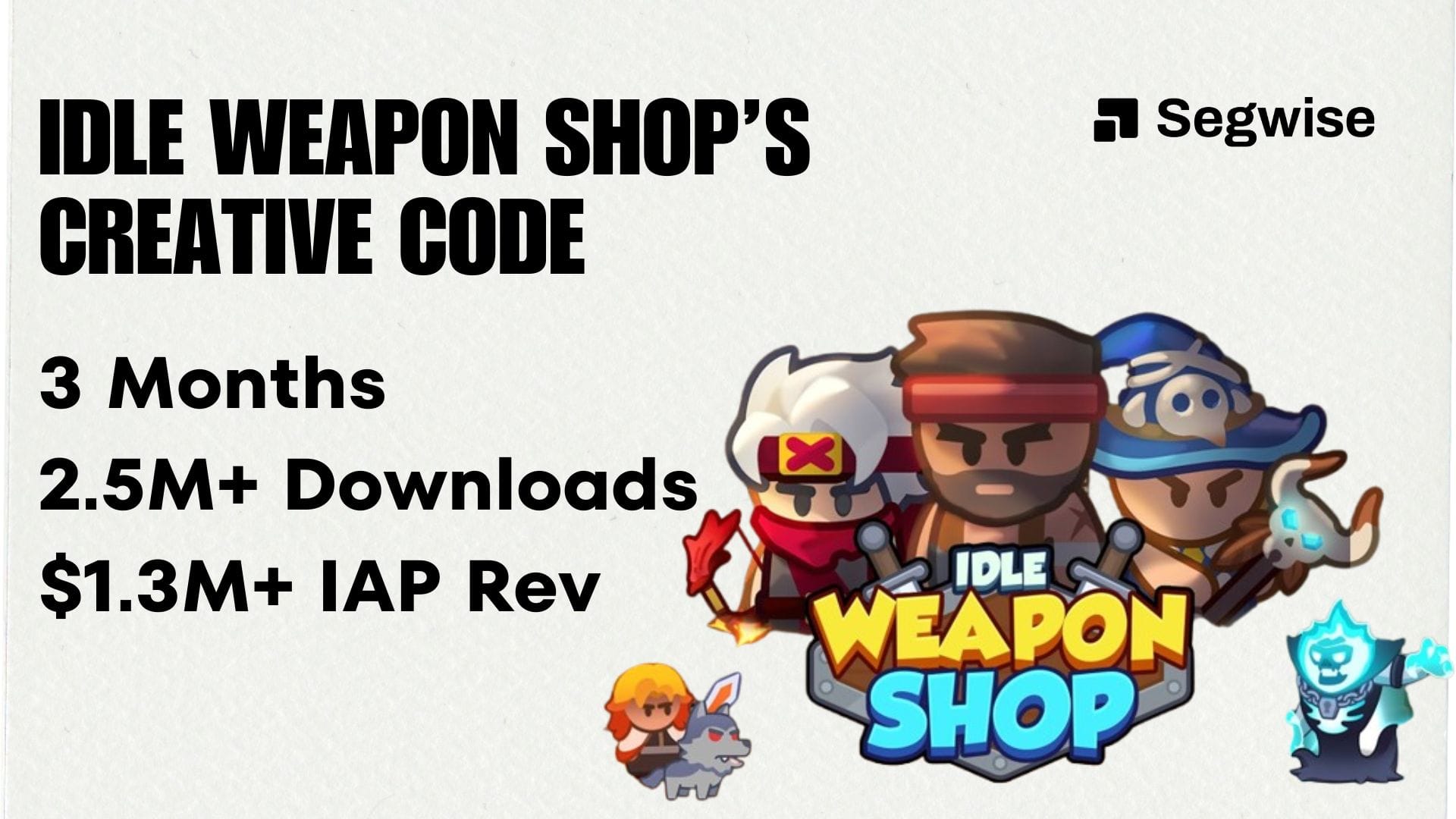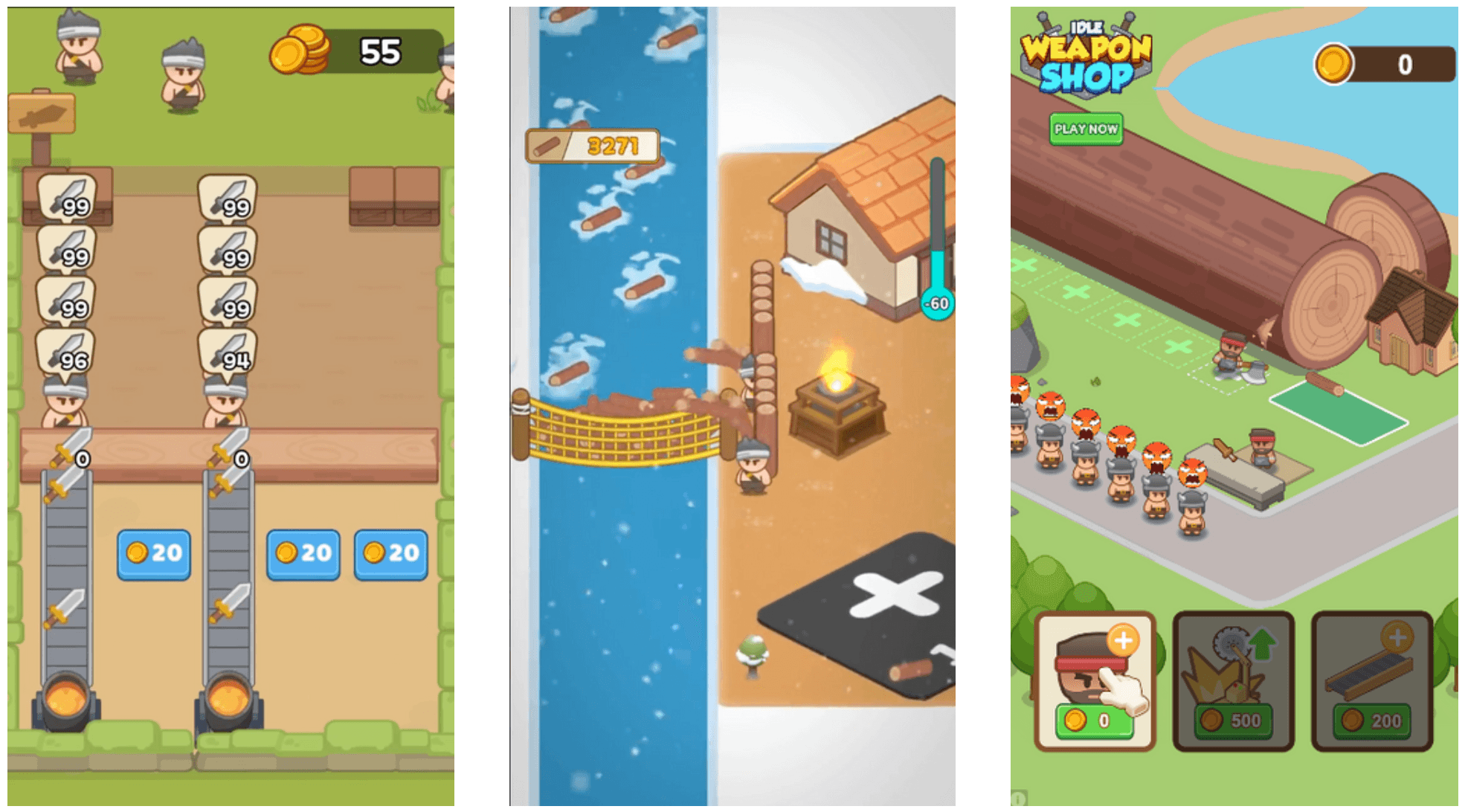How Idle Weapon Shop Cracked the Creative Code: 300M+ Playable Ad Impressions
Updated for April 2025. Packed with actionable frameworks, examples, and industry-best practices.

Introduction
UA managers and performance marketers:
Ever wondered why some games rocket past their peers with the ad everyone remembers? Idle Weapon Shop’s creative strategy is a masterclass - achieving 205M+ impressions with a single playable and over $1.3 million in IAP revenue in 3 months since launch! Playable ads are leading the charge for Idle Weapon Shops creative strategy.
Why this matters
Mobile user acquisition is like a battlefield. You’re competing on cost, creativity, and speed. Catching the next creative trend, or missing it can mean the difference between scaling profitably and blowing your budget.
This post:
- Dissects exactly what Idle Weapon Shop did with its ad strategy
- Gives you a toolkit to apply winning patterns to your own UA campaigns
- Highlights mistakes to avoid and shows you how to future-proof your efforts
Also check out How Cookingdom Cracked the Creative Code
1. Playables-First: The Anatomy of a Winning Ad
The Core Strategy
Idle Weapon Shop didn’t just “run playables.” They built ads that made users desperate to know what happens next:
- Cliffhanger Playables: Ads cut off mid-action - imagine a sword about to be forged for your warriors, then the screen fades to download. It’s Netflix for game ads. (reference from actual playable ads)
- Pressure & Urgency Mechanics: Countdowns and visibly impatient in-game characters push users to act.
- Guided Cues: On-screen tutorial hands and arrows make gameplay instantly clear, even to someone who’s never seen your game.
Pro Tip: Don’t just A/B test creatives, A/B test your FOMO moment. Sometimes, what you hide is what gets the click.
Minimalist Hooks, Maximum Emotion
- No text overlays, no shouting: The ads rely on character emotion and urgent situations.
- Even UGC-style ads with narrative voice overs (which they tested) stuck to core gameplay drama eventually, avoiding empty viral tropes.
Always-On Branding & Global Reach
- Branding is on-screen at all times, improving recall and trust.
- Wide geo-testing: Top markets included Brazil, South Korea, Ukraine, Indonesia, Germany, and the US.
Source: AppMagic Ad Intelligence, April 2025
2. Beyond Basics: Creative Experimentation & Advanced Tactics
What Else Did They Test?
A. Borrowing & Blending Mechanics
Borrowing from other hit games (e.g., Whiteout Survival) to test cross-genre appeal, an advanced form of “trendjacking.”
B. Embellished Gameplay
Some creatives showcased “advanced” features not yet live, boosting perceived depth and excitement.
C. UGC & Narrative Formats
Testing UGC videos, but keeping gameplay pressure central, never just generic endorsements.
D. HTML Video and Network Diversification
Pure HTML video ads tested on AppLovin, Unity, and Mintegral for in-app placement diversity.
Disclaimer: Ad network policies (e.g., AppLovin, Unity) are subject to change. Always review current guidelines before launching new ad formats.

3. Actionable Framework: Replicate Idle Weapon Shop’s Success
Copy, Adapt, Win—Step by Step
Creative Review Checklist:
- Is your playable ad cut off at a moment of high tension?
- Do you use countdowns, timers, or impatient character cues?
- Is your branding always visible?
- Are tutorial hands/arrows making gameplay clear?
- Did you test at least one cross-genre mechanic?
- Are your UGC ads pressure-driven, not just “happy user” fluff?
- Have you A/B tested playables vs HTML video in all your major geos?
Step-by-Step Guide
- Storyboard your cliffhanger: Choose a “pain point” or moment of suspense to end the playable.
- Script urgency: Build in timers, angry/waiting characters, or rewards about to expire.
- Iterate on format: Try both playables and HTML video. Measure not just CTR, but D1 retention, D1 ROAS and downstream revenue.
- Leverage AI-powered analytics: Use Segwise's AI Creative Agent to automatically tag, analyze, and compare creative results across networks.
- Don’t set and forget: Use Segwise's simplified and consolidated creative dashboards to watch drop-off points and iterate every week.
4. Expert Insights & Lessons Learned (Powered by Winning Patterns Data)
What separates high-performing UA campaigns? The data from Segwise’s Winning Patterns report offers clear takeaways—especially around playables and creative tagging:
Playable Ad Insights
Playables = Performance
- Puzzle games: 36% of top creatives were playables—confirming their dominance in the genre.
- Strategy games: Only 13% were standalone playables, but 56% used playables after a video lead-in, showing that hybrid formats are now the norm.
- Simulation games: 80% of ads prioritized gameplay, with nearly 60% using hybrid creative formats (e.g., gameplay + animation).d1d1d6d9-9384-4b72-845a…
Guidance & Clarity
- 100% of winning playables featured guiding elements like hovering hands or arrows to instantly orient the user.
- 80% included hook scene texts, with 70% of those being instructional (e.g., “Can you conquer this?” or “Swipe to win!”).
- Instructional/challenging text types outperform pure teasers. Tell the player what to do or challenge them, not just tease.
Cliffhanger Endings & FOMO
- Over 70% of playables ended abruptly—leaving the player hanging and fueling curiosity.
- The best ads engineered FOMO by stopping at “almost-win” or high-tension moments, driving downloads.
Emotion Wins
- 68% of puzzle creatives used characters in distress, not just neutral or happy expressions.
- Distressed characters and visible pressure mechanics (like countdowns or IQ meters) amplified urgency and user intent.
Mechanics Fusion
- Top ads in strategy and puzzle genres blended game mechanics (e.g., horde/survival + defense building).
- Hybrid formats (gameplay + animation/UGC, or playables with lead-in videos) consistently boosted engagement and retention.
Lessons & Pitfalls (From the Data)
Instruction Beats Gimmicks: Ads with instructional or challenging hook text outperformed generic teasers. Directly tell or challenge the user.
Always Guide: Every playable should use tutorial cues (hands/arrows). This correlated with higher completion and post-click retention.
End on a Cliffhanger: Abrupt, unresolved endings (cliffhangers) consistently drove curiosity and installs.
Hybrid Formats Win: Blending playables with lead-in videos or mixing animation/UGC boosted engagement, especially in strategy and simulation genres.
Lead with Emotion: “Distressed” or urgent character expressions drove more engagement than happy/neutral.
Show Game Depth: 27% of puzzle ads showcased multiple levels, letting users visualize deeper progression—not just a single mechanic.
Want granular winning patterns and actionable creative frameworks?
5. FAQs and Troubleshooting
Q: What if playables underperform vs. video in my game?
A: Analyze drop-off points and test new FOMO moments; hybrid formats (interactive video with cut-offs) can bridge the gap.
Q: How do I know which moment to “cut” for maximum FOMO?
A: Use analytics to track engagement spikes, then A/B test ad endings at those moments.
Q: Can these strategies work for non-idle genres?
A: Absolutely—urgency and cliffhanger tactics are genre-agnostic.

Comments
Your comment has been submitted successfully!